Submitted:
16 June 2023
Posted:
19 June 2023
You are already at the latest version
Abstract
Keywords:
1. Introduction
2. Materials and Methods
2.1. Sampling
2.2. Gross anatomy and morphometric analysis
2.3. Scanning electron microscopy examination
2.4. Coloring of scanning electron microscopic images
3. Results
3.1. Gross anatomy and morphometric analysis of the tongue
3.2. Scanning electron microscopy of the tongue and their lingual papillae
3.3. Lingual apex
3.4. Lingual body and torus linguae
3.5. Lingual root
4. Discussion
5. Conclusions
Funding
Institutional Review Board Statement
Informed Consent Statement
Data Availability Statement
Acknowledgments
Conflicts of Interest
References
- Abumandour, M. and R. El-Bakary, Anatomic reference for morphological and scanning electron microscopic studies of the New Zealand white rabbits tongue (Orycotolagus cuniculus) and their lingual adaptation for feeding habits. Journal of morphological sciences, 2013. 30(4): p. 260-271.
- Erdoğan, S., S. Villar Arias, and W. Pérez, Morphofunctional structure of the lingual papillae in three species of South American Camelids: alpaca, guanaco, and llama. Microscopy research and technique, 2016. 79(2): p. 61-71. [CrossRef]
- Mahdy, M.A.A., K.E. Abdalla, and S.A. Mohamed, Morphological and scanning electron microscopic studies of the lingual papillae of the tongue of the goat (Capra hircus). Microscopy Research and Technique, 2021. 84(5): p. 891-901. [CrossRef]
- Scala, G., N. Mirabella, and G. Pelagalli, Morphofunctional study of the lingual papillae in cattle (Bos taurus). Anatomia, histologia, embryologia, 1995. 24(2): p. 101-105.
- Emura, S., et al., Morphology of the lingual papillae in the raccoon dog and fox. Okajimas folia anatomica Japonica, 2006. 83(3): p. 73-76. [CrossRef]
- Goodarzi, N. and T. Hoseini, Fine structure of lingual papillae in the Markhoz goat (Iranian Angora): a scanning electron microscopic study. International Journal of Zoological Research, 2015. 11(4): p. 160-168. [CrossRef]
- Kurtul, I. and S. Atalgın, Scanning electron microscopic study on the structure of the lingual papillae of the Saanen goat. Small Ruminant Research, 2008. 80(1-3): p. 52-56. [CrossRef]
- Abd Murad, N., N.H. Hassan, and T.A. Abid, Anatomical study of the tongue in adult rams. Kufa Journal for Veterinary Medical Sciences, 2010. 1(2): p. 48-57.
- Tadjalli, M. and R. Pazhoomand, Tongue papillae in lambs: a scanning electron microscopic study. Small Ruminant Research, 2004. 54(1-2): p. 157-164. [CrossRef]
- Unsal, S., et al., The number and distribution of fungiform papillae and taste buds in the tongue of young and adult Akkaraman sheep. Revue de médecine vétérinaire, 2003. 154(11): p. 709-714.
- Farrag, F.A., et al., Ultrastructural features on the oral cavity floor (tongue, sublingual caruncle) of the Egyptian water buffalo (Bubalus bubalis): gross, histology and scanning electron microscope. Folia Morphologica.10.5603/FM.a2021.0061., 2021. [CrossRef]
- Fu, J., Z. Qian, and L. Ren, Morphologic Effects of Filiform Papilla Root on the Lingual Mechanical Functions of Chinese Yellow Cattle. International Journal of Morphology, 2016. 34(1): p. 63–70. [CrossRef]
- Sari, E.K., M.K. Harem, and I.S. Harem, Characteristics of dorsal lingual papillae of Zavot cattle. Journal of animal and veterinary advances, 2010. 9(1): p. 123-130.
- EErdunchaolu and Baiyin, Characteristics of dorsal lingual papillae of the Bactrian camel (Camelus bactrianus). Anatomia, Histologia, Embryologia, 2001. 30(3): p. 147-151.
- Abd-Elnaeim, M.M., A.E. Zayed, and R. Leiser, Morphological characteristics of the tongue and its papillae in the donkey (Equus asinus): a light and scanning electron microscopical study. Annals of Anatomy-Anatomischer Anzeiger, 2002. 184(5): p. 473-480. [CrossRef]
- Kobayashi, K., et al., Comparative morphological study on the tongue and lingual papillae of horses (Perissodactyla) and selected ruminantia (Artiodactyla). Italian journal of anatomy and embryology= Archivio italiano di anatomia ed embriologia, 2005. 110(2 Suppl 1): p. 55-63.
- Kumar, S. and L.A. Bate, Scanning electron microscopy of the tongue papillae in the pig (Sus scrofa). Microscopy research and technique, 2004. 63(5): p. 253-258. [CrossRef]
- Massoud, D. and M.M. Abumandour, Descriptive studies on the tongue of two micro-mammals inhabiting the Egyptian fauna; the Nile grass rat (Arvicanthis niloticus) and the Egyptian long-eared hedgehog (Hemiechinus auritus). Microscopy research and technique, 2019. 82(9): p. 1584-1592. [CrossRef]
- Hofmann, R.R., Evolutionary steps of ecophysiological adaptation and diversification of ruminants: A comparative view of their digestive system. Oecologia, 1989. 78(4): p. 443–457. [CrossRef]
- Pugh, D.G., Sheep & Goat Medicine-E-book 2001, London, UK: Elsevier Health Sciences.
- Dyce, K.M., W.O. Sack, and C.J.G. Wensing, Textbook of veterinary anatomy (4th ed.). 2010, St. Louis, MO: Saunders/Elsevier.
- Akers, R.M. and D.M. Denbow, Anatomy and physiology of domestic animals. 2013, Oxford, England: John Wiley & Sons.
- König, H.E., et al., G.Digestive system (apparatus digestorius). In H. E. König & H.-G. Liebich (Eds.),Veterinary anatomy of domestic mammals: Textbook and colour atlas (7th ed., pp. 327–395). 2020, Stuttgart, Germany: Thieme.
- Ginane, C., R. Baumont, and A. Favreau-Peigné, Perception and hedonic value of basic tastes in domestic ruminants. Physiology & behavior, 2011. 104(5): p. 666-674. [CrossRef]
- Thome, H., Mundhöhle und Schlundkopf. In: Nickel, R., Schummer, A., Seiferle, E. (Eds.), Lehrbuch der Anatomie der Haustiere, 8. Aufl., Bd. II. . Lehrbuch der Anatomie der Haustiere. Bd. II, Aufl. Vol. (Vol. 8. 1999, Berlin: Parey Buchverlag. [CrossRef]
- Currie, W.B., Structure and function of domestic animals. 1992, Boca Raton: CRC Press. [CrossRef]
- Madkour, F.A. and E.S. Mohammed, Histomorphological investigations on the lips of Rahmani sheep (Ovis aries): A scanning electron and light microscopic study. Microscopy Research and Technique, 2021. 84(5): p. 992-1002. [CrossRef]
- Madkour, F.A., et al., Morphometrical, histological, and scanning electron microscopic investigations on the hard palate of Rahmani sheep (Ovis aries). Microscopy Research and Technique, 2022. 85(1): p. 92–105.
- Silva, T.M., et al., Ingestive behavior and physiological parameters of goats fed diets containing peanut cake from biodiesel. Tropical animal health and production, 2016. 48(1): p. 59-66. [CrossRef]
- Madkour, F.A. and M. Abdelsabour-Khalaf, Scanning electron microscopy of the nasal skin in different animal species as a method for forensic identification. Microscopy Research and Technique, 2022a. 85(5): p. 1643-1653. [CrossRef]
- Madkour, F.A. and M. Abdelsabour-Khalaf, Performance scanning electron microscopic investigations and elemental analysis of hair of the different animal species for forensic identification. Microscopy research and technique, 2022b. [CrossRef]
- Soliman, S.A., et al., Role of Uterine Telocytes During Pregnancy. Microscopy and Microanalysis, 2023. 29(1): p. 283-302. [CrossRef]
- Sayed, M., et al., Sperm tendency to agglutinate in motile bundles in relation to sperm competition and fertility duration in chickens. Scientific Reports, 2022. 12(1): p. 18860. [CrossRef]
- El-Sherry, T.M., H.H. Abd-Elhafeez, and M. Sayed, New insights into sperm rheotaxis, agglutination and bundle formation in Sharkasi chickens based on an in vitro study. Scientific Reports, 2022. 12(1): p. 13003. [CrossRef]
- Meier, A.R., et al., Convergence of macroscopic tongue anatomy in ruminants and scaling relationships with body mass or tongue length. Journal of Morphology, 2016. 277(3): p. 351–362. [CrossRef]
- Jackowiak, H., et al., Anatomy of the tongue and microstructure of the lingual papillae in the fallow deer Dama dama (Linnaeus, 1758). Mammalian Biology, 2017. 85(1): p. 14-23. [CrossRef]
- Ding, Y., S. Yu, and B. Shao, Anatomical and histological characteristic of the tongue and tongue mucosa linguae in the cattle-yak (Bos taurus× Bos grunniens). Frontiers in biology, 2016. 11(2): p. 141-148. [CrossRef]
- El-Bably, S. and A. Tolba, Morph-metrical studies on the tongue (Lingua) of the adult Egyptian domestic cats (Felis domestica). International Journal of Veterinary Science, 2015. 4(2): p. 69-74.
- Yoshimura, K., et al., Comparative morphology of the lingual papillae and their connective tissue cores in the tongue of the American mink, Neovison vison. Zoological science, 2014. 31(5): p. 292-299. [CrossRef]
- Jackowiak, H. and S. Godynicki, The distribution and structure of the lingual papillae on the tongue of the bank vole Clethrinomys glareolus. Folia Morphologica, 2005. 64(4): p. 326-333.
- Ciena, A.P., et al., Structural and ultrastructural features of the agouti tongue (D asyprocta aguti L innaeus, 1766). Journal of Anatomy, 2013. 223(2): p. 152-158.
- Wolczuk, K., Dorsal Surface of the Tongue of the Hazel Dormouse Muscardinus Avellanarius: Scanning Electron and Light Microscopic Studies/Grzbietowa Powierzchnia Jezyka Orzesznicy Muscardinus Avellanarius: Badania Z Wykorzystaniem Mikroskopu Skaningowego I Swietlnego. Zoologica Poloniae, 2014. 59(1-4): p. 35.
- Atoji, Y., Y. Yamamoto, and Y. Suzuki, Morphology of the tongue of a male Formosan serow (Capricornis crispus swinhoei). Anatomia, histologia, embryologia, 1998. 27(1): p. 17-19. [CrossRef]
- El-Bakary, N. and M. Abumandour, Morphological studies of the tongue of the Egyptian water buffalo (Bubalus bubalis) and their lingual papillae adaptation for its feeding habits. Anatomia, histologia, embryologia, 2017. 46(5): p. 474-486. [CrossRef]
- Mqokeli, B. and C. Downs, Palatal and lingual adaptations for frugivory and nectarivory in the Wahlberg’s epauletted fruit bat (Epomophorus wahlbergi). Zoomorphology, 2013. 132(1): p. 111-119. [CrossRef]
- Yoshimura, K., J. Shindoh, and K. Kobayashi, Scanning electron microscopy study of the tongue and lingual papillae of the California sea lion (Zalophus californianus californianus). The Anatomical Record, 2002. 267(2): p. 146-153.
- Jackowiak, H., J. Trzcielinska-Lorych, and S. Godynicki, The microstructure of lingual papillae in the Egyptian fruit bat (Rousettus aegyptiacus) as observed by light microscopy and scanning electron microscopy. Archives of histology and cytology, 2009. 72(1): p. 13-21. [CrossRef]
- Can, M., et al., Scanning electron microscopic study on the structure of the lingual papillae of the Karacabey Merino sheep. Eurasian Journal of Veterinary Sciences, 2016. 32(3): p. 130-135. [CrossRef]
- Iwasaki, S.-i., Erdo gan, S., & Asami, T., Evolutionary specialization of the tongue in vertebrates: Structure and function. In V. Bels & I. Q. Whishaw (Eds.), Feeding in vertebrates: Evolution, morphology, behavior, biomechanics (pp. 333–384). Cham: Springer International Publishing. 2019.
- Mahdy, M.A.A., Three-dimensional study of the lingual papillae and their connective tissue cores in the Nile fox (Vulpes vulpes aegyptica) (Linnaeus, 1758). Microscopy research and technique, 2021. 84(11): p. 2716-2726.
- Yoshimura, K., J. Shindo, and I. Kageyama, Light and scanning electron microscopic study on the tongue and lingual papillae of the Japanese badgers, Meles meles anakuma. Okajimas folia anatomica Japonica, 2009. 85(4): p. 119-27. [CrossRef]
- Ghasem, A., B. Mohammad, and H. Belal, Morphological study of the European hedgehog (Erinaceuseuropaeus) tongue by SEM and LM. Anatomical science international, 2017. 93(2): p. 207-217.
- Erdoğan, S. and W. Pérez, Anatomical and scanning electron microscopic characteristics of the tongue in the pampas deer (Cervidae: Ozotoceros bezoarticus, Linnaeus 1758). Microscopy Research and Technique, 2013. 76(10): p. 1025-34. [CrossRef]
- Jabbar, A.I., Macroscopical and microscopical observations of the tongue in the Iraqi goat (Capra hircus). International Journal of Advanced Research, 2014. 2(6): p. 642-648.
- Erdoğan, S. and H. Sağsöz, Papillary Architecture and Functional Characterization of Mucosubstances in the Sheep Tongue. Anatomical record, 2018. 301(8): p. 1320-1335. [CrossRef]
- Adnyane, I., et al., Morphological study of the lingual papillae in the barking deer, Muntiacus muntjak. Anatomia, Histologia, Embryologia, 2011. 40(1): p. 73-77. [CrossRef]
- Mahabady, M.K., H. Morovvati, and K. Khazaeil, A microscopic study of lingual papillae in Iranian buffalo (Bubalus bubalus). Asian journal of Animal and Veterinary Advances, 2010. 5(2): p. 154-161. [CrossRef]
- Arvidson, K. and U. Friberg, Human taste: response and taste bud number in fungiform papillae. Science, 1980. 209(4458): p. 807-808. [CrossRef]
- Conger, A.D. and M.A. Wells, Radiation and aging effect on taste structure and function. Radiation research, 1969. 37(1): p. 31-49. [CrossRef]
- Schiffman, S., M. Orlandi, and R.P. Erickson, Changes in taste and smell with age: Biological aspects. Sensory systems and communication in the elderly, 1979. 10: p. 247-268.
- Harem, M.K., et al., Light and scanning electron microscopic study of the dorsal lingual papillae of the Goitered gazelle (Gazelle subgutturosa). Journal of Animal and Veterinary Advances, 2011. 10(15): p. 1906-1913. [CrossRef]
- Emura, S. and N.E. El Bakary, Morphology of the lingual papillae of Egyptian buffalo (Bubalus bubalis). Okajimas Folia Anatomica Japonica 2014. 91(1): p. 13-7. [CrossRef]
- Emura, S., et al., Morphology of the dorsal lingual papillae in the barbary sheep, Ammotragus lervia. Okajimas Folia Anatomica Japonica, 2000. 77(2-3): p. 39-45. [CrossRef]
- Kokubun, H.S., et al., Estudo histológico e comparativo das papilas linguais dos cervídeos Mazama americana e Mazama gouzoubira por microscopia de luz e eletrônica de varredura. Pesquisa Veterinária Brasileira, 2012. 32: p. 1061-1066. [CrossRef]
- Ciena, A.P., et al., Structural and ultrastructural features of the agouti tongue (D asyprocta aguti L innaeus, 1766). Journal of Anatomy, 2013. 223(2): p. 152-158.
- Burity, C.H.d.F., et al., Scanning electron microscopic study of the tongue in golden-headed lion tamarins, Leontopithecus chrysomelas (Callithrichidae: Primates). Zoologia (Curitiba), 2009. 26(2): p. 323-327.
- Park, H. and E.R. Hall, The gross anatomy of the tongues and stomachs of eight New World bats. Transactions of the Kansas Academy of Science (1903-), 1951. 54(1): p. 64-72. [CrossRef]
- Watanabe, I.-s., et al., Scanning electron microscopy study of the interface epithelium-connective tissue surface of the lingual mucosa in Calomys callosus. Annals of Anatomy-Anatomischer Anzeiger, 1997. 179(1): p. 45-48. [CrossRef]
- Emura, S., T. Okumura, and H. Chen, Morphology of the lingual papillae and their connective tissue cores in the cape hyrax. Okajimas Folia Anatomica Japonica, 2008. 85(1): p. 29-34. [CrossRef]
- Chamorro, C., et al., Comparative scanning electron-microscopic study of the lingual papillae in two species of domestic mammals (Equus caballus and Bos taurus). 1. Gustatory Papillae. Acta anatomica, 1986. 125(2): p. 83-87. [CrossRef]
- Kobayashi, K., et al., Three dimensional structure of the connective tissue papillae of cat lingual papillae. Japanese Journal of Oral Biology, 1988. 30(6): p. 719-731.
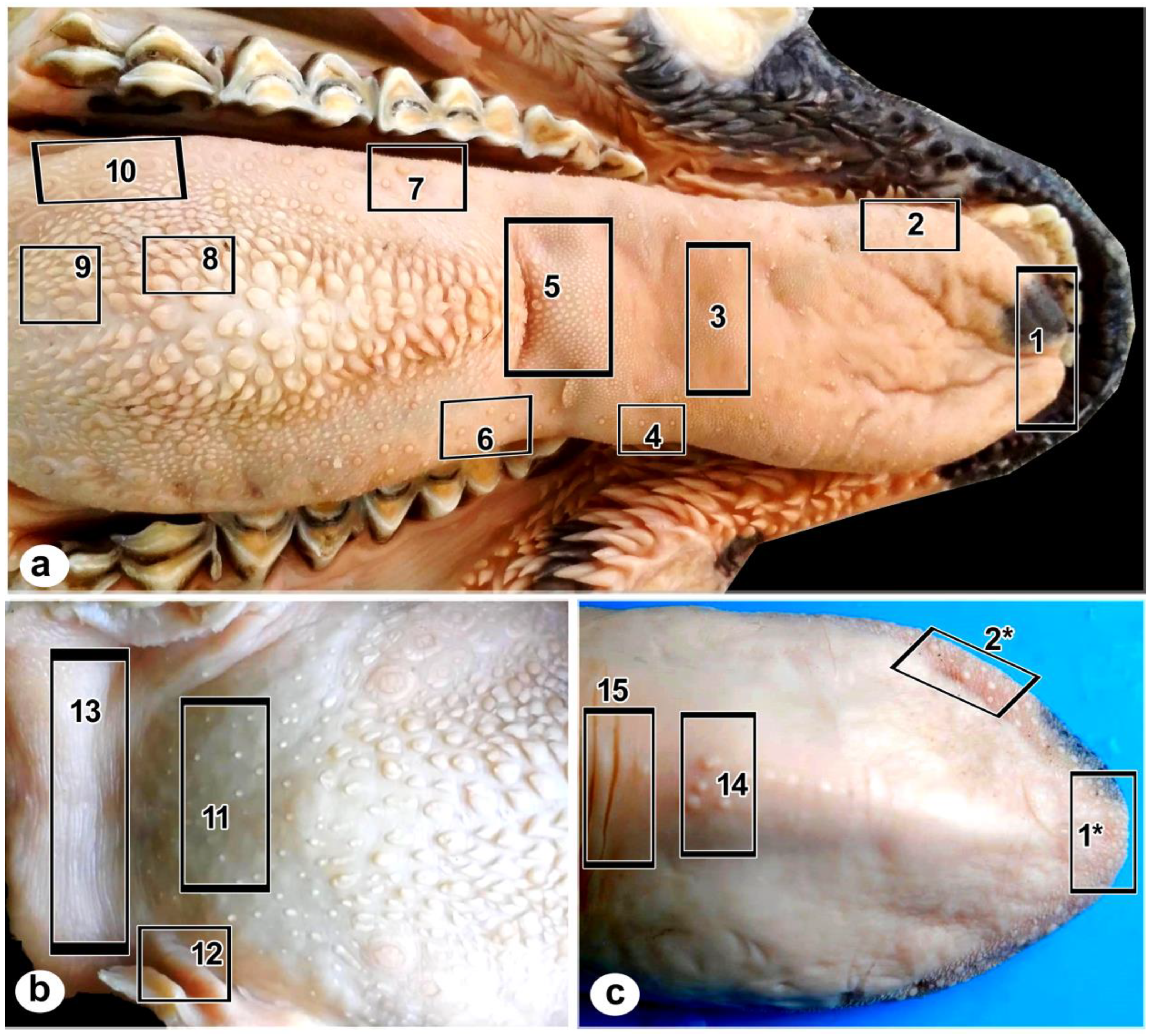
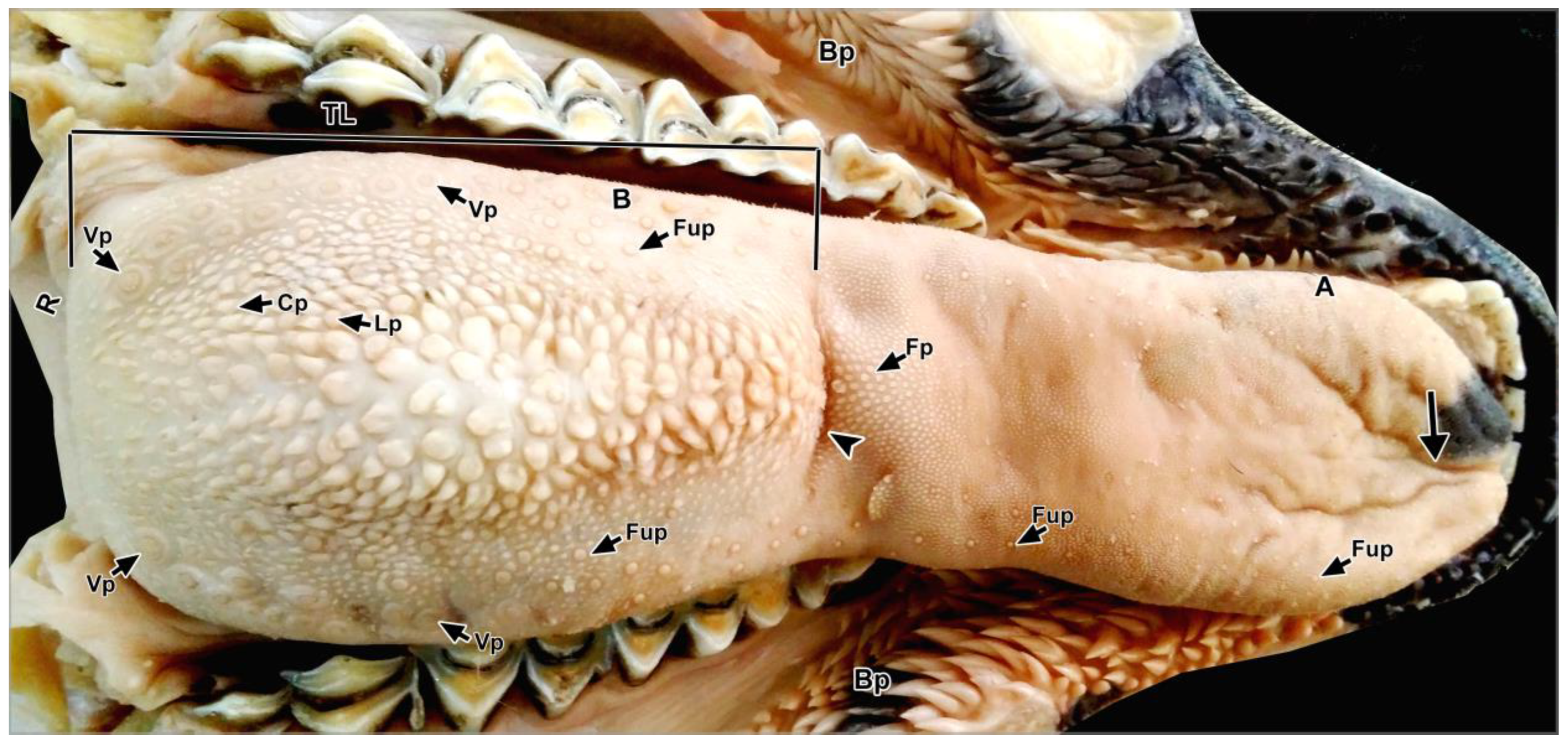
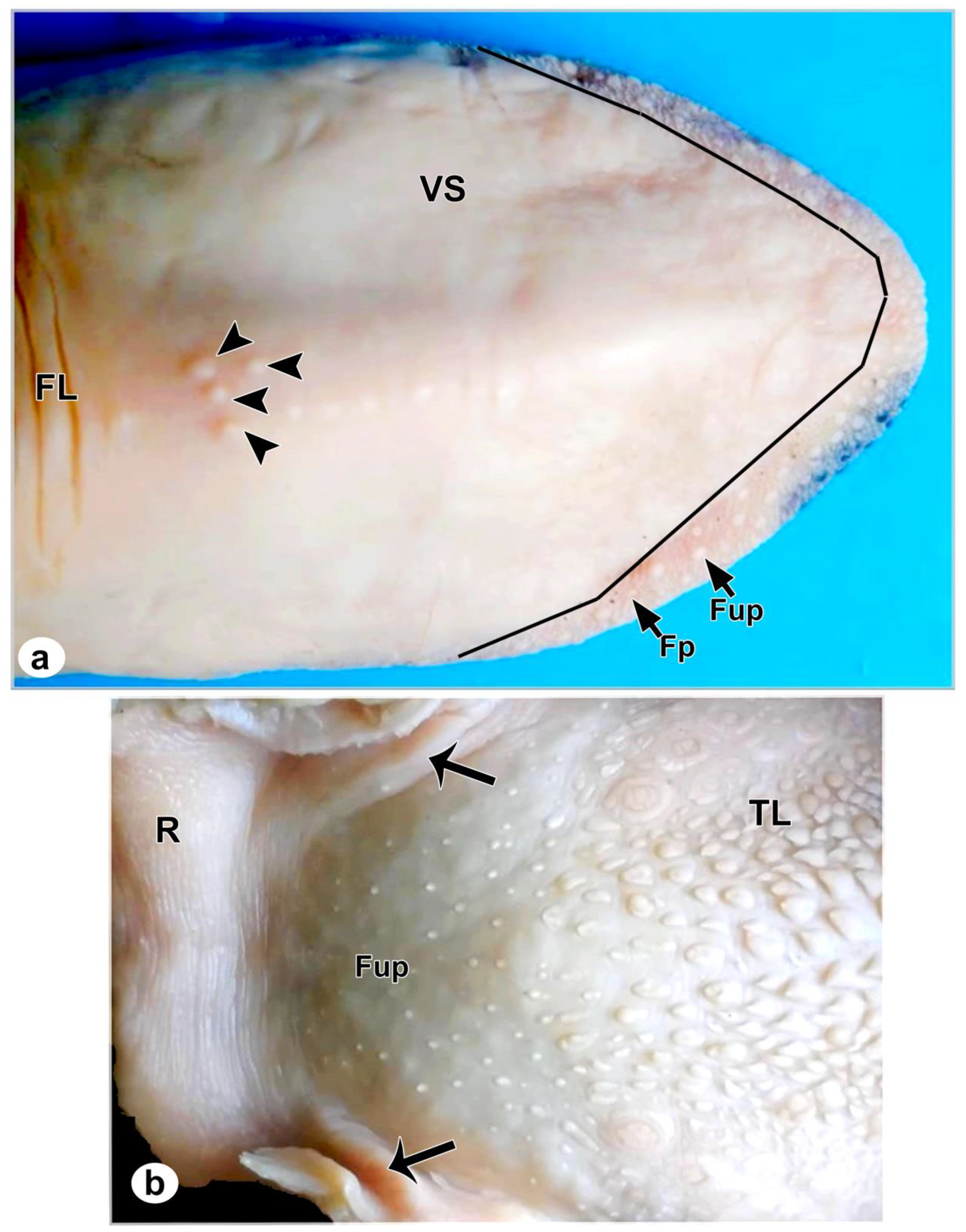
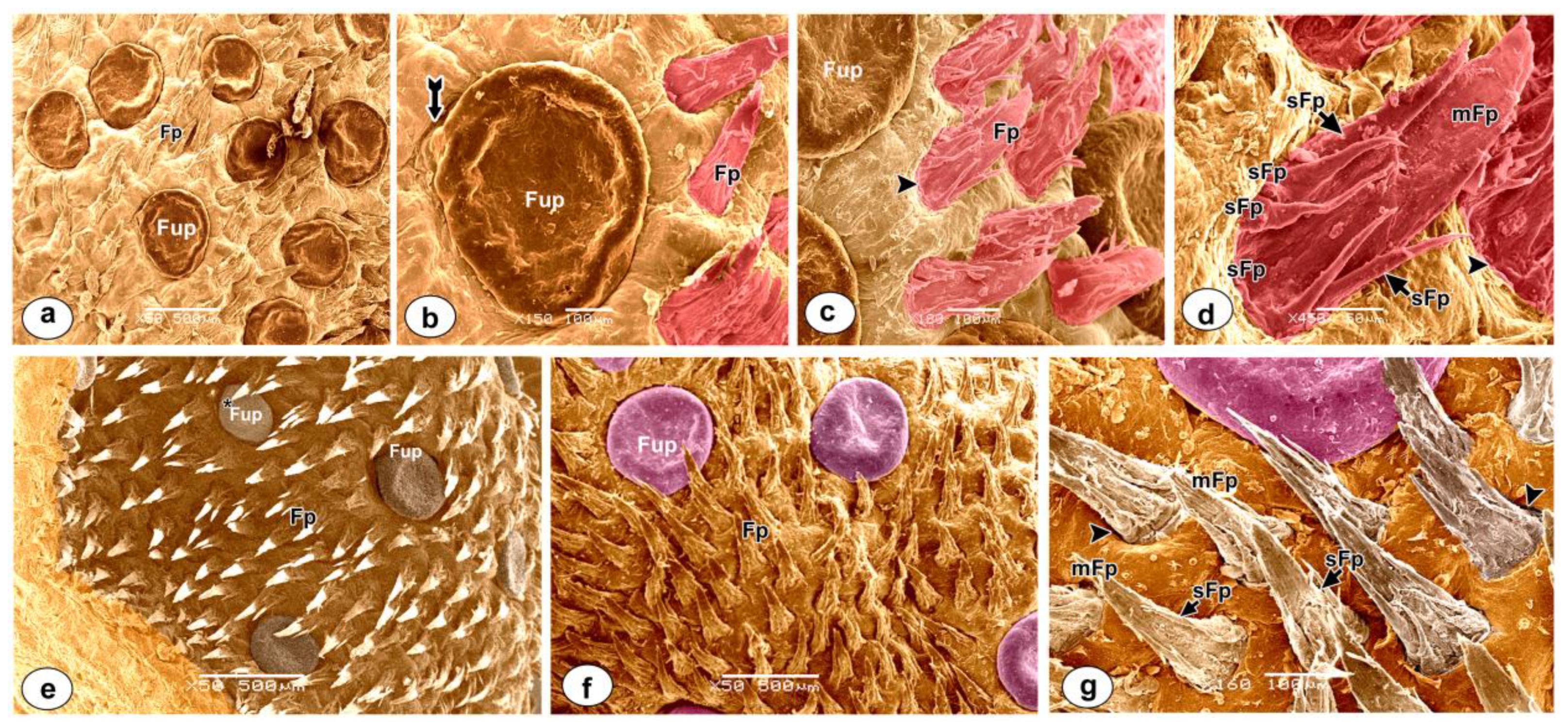
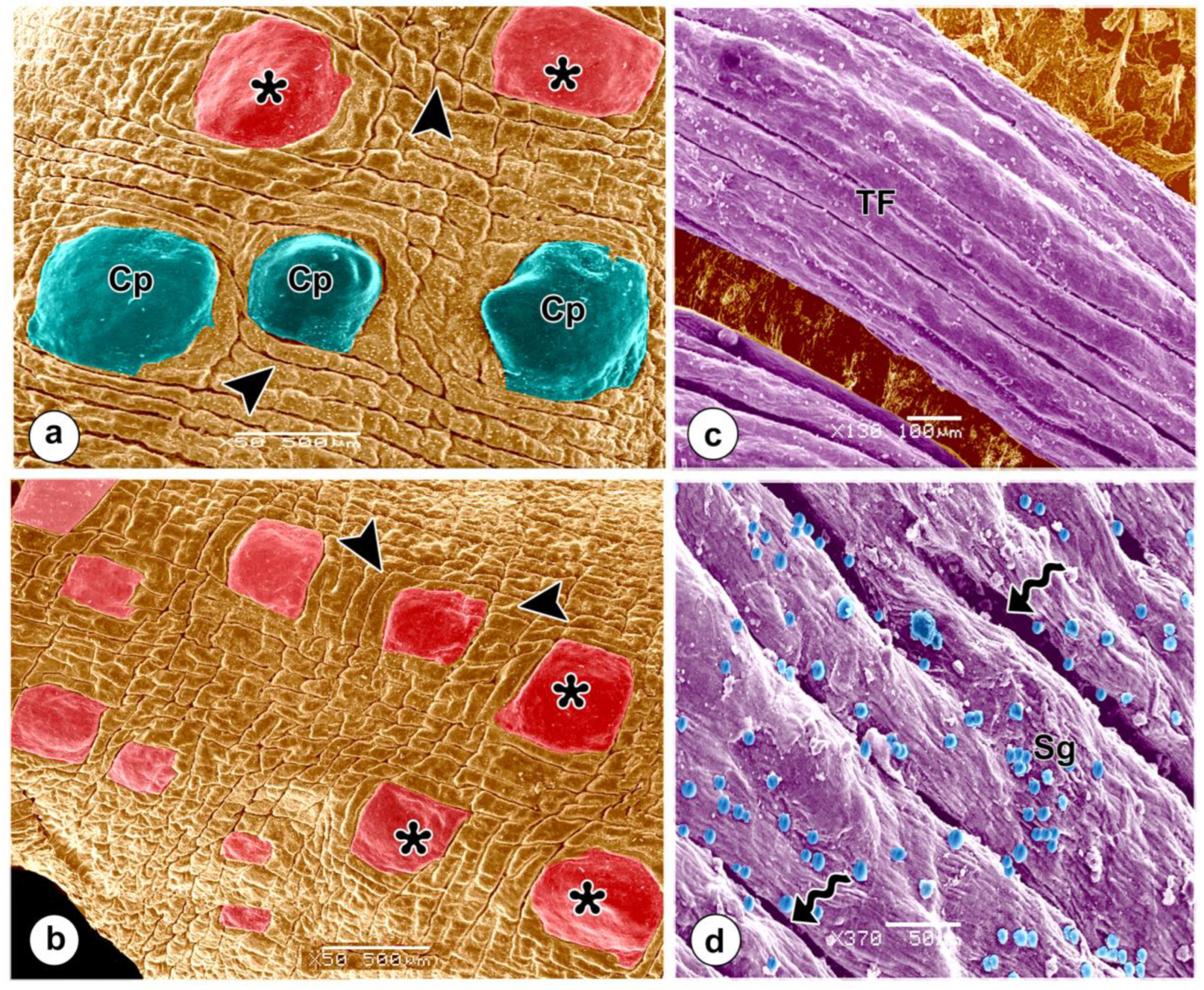
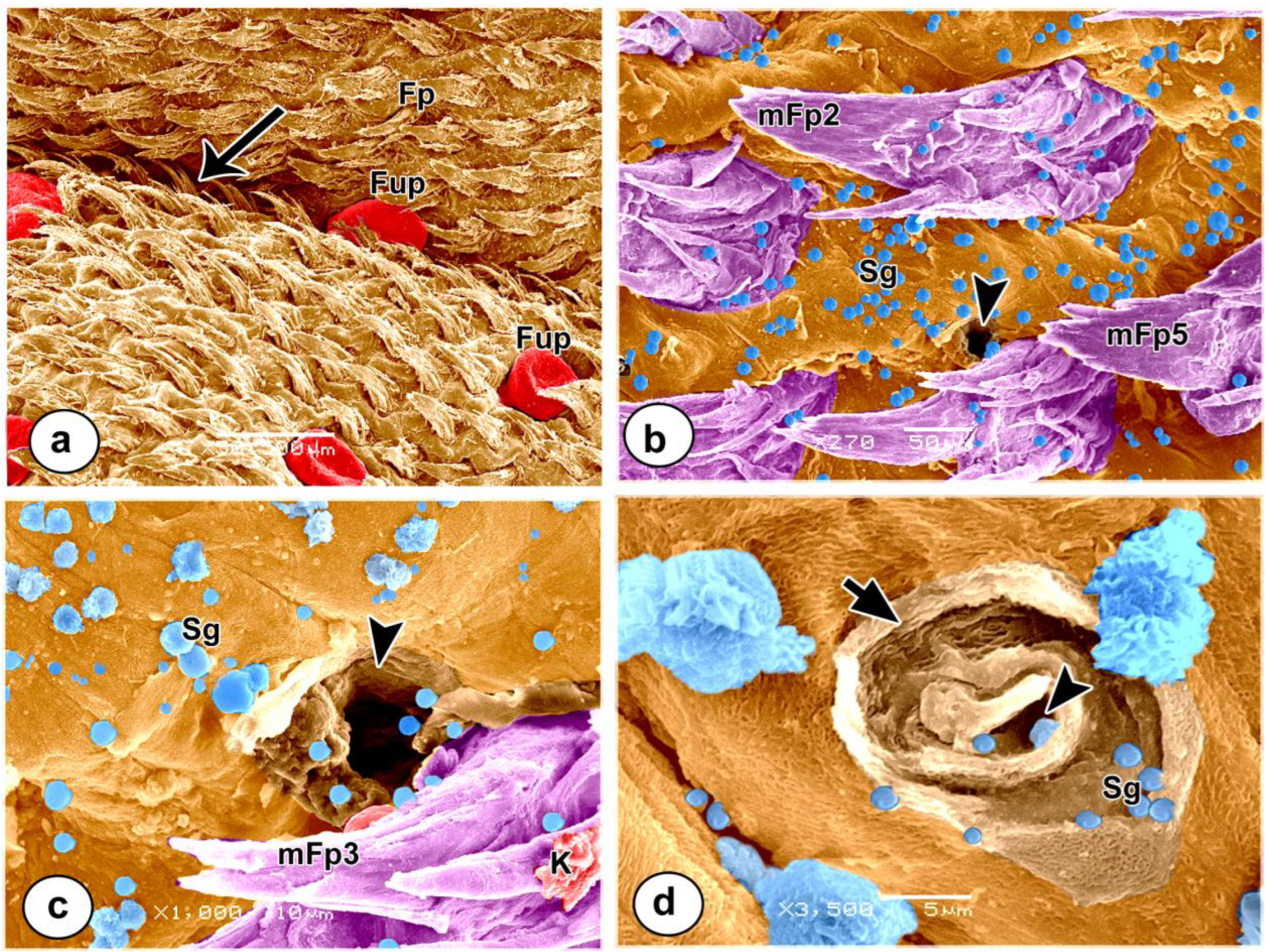
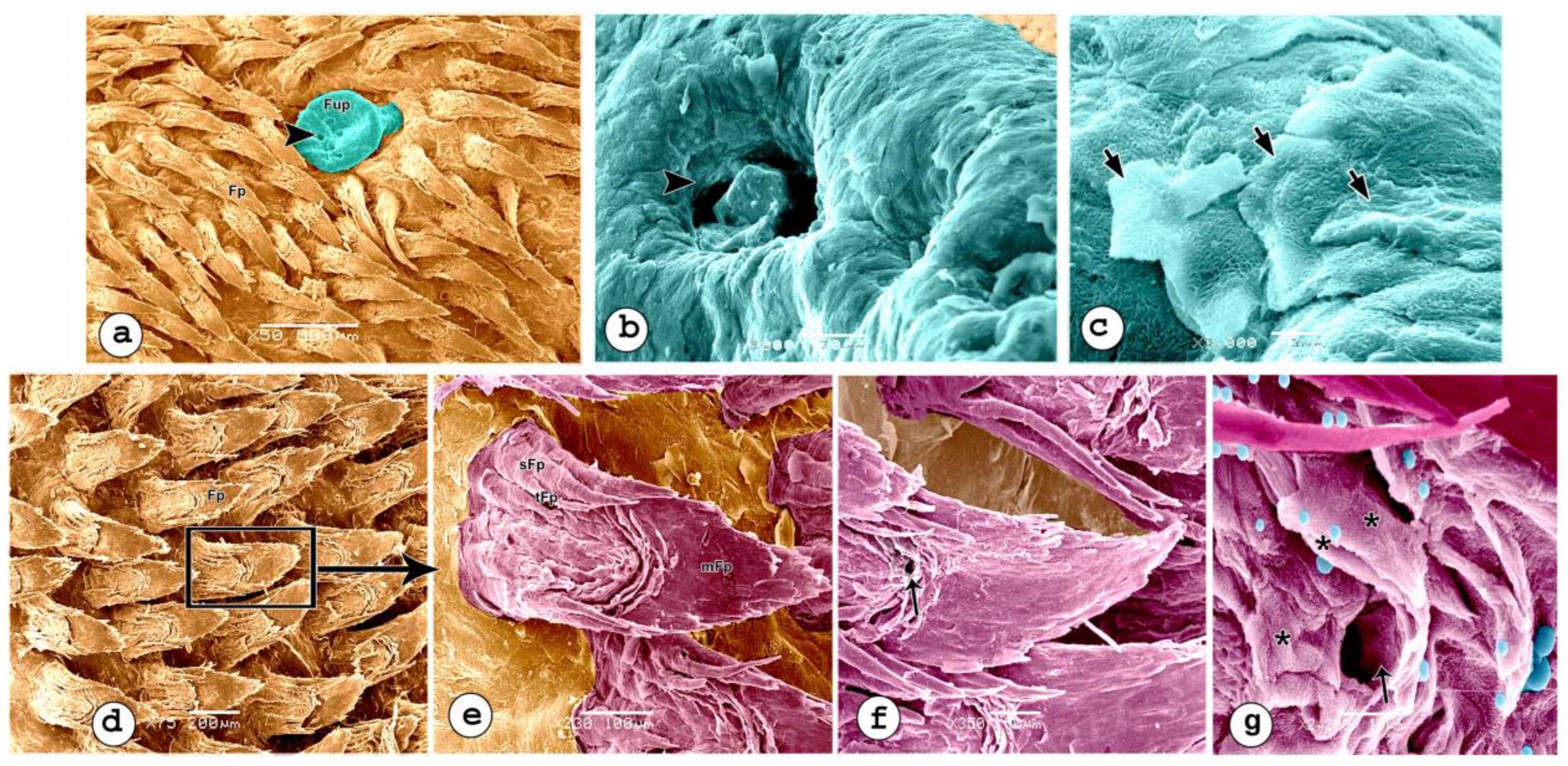
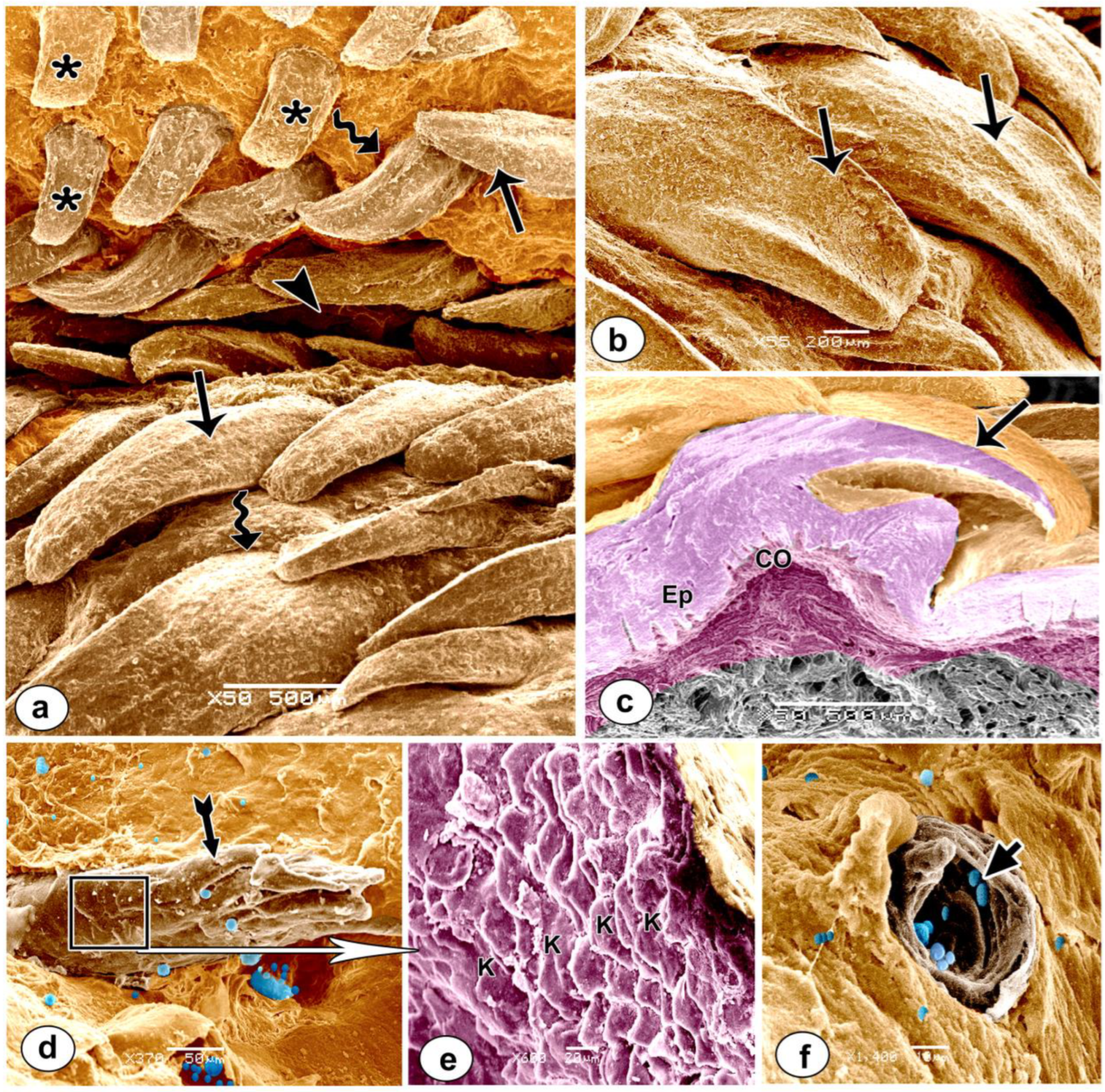
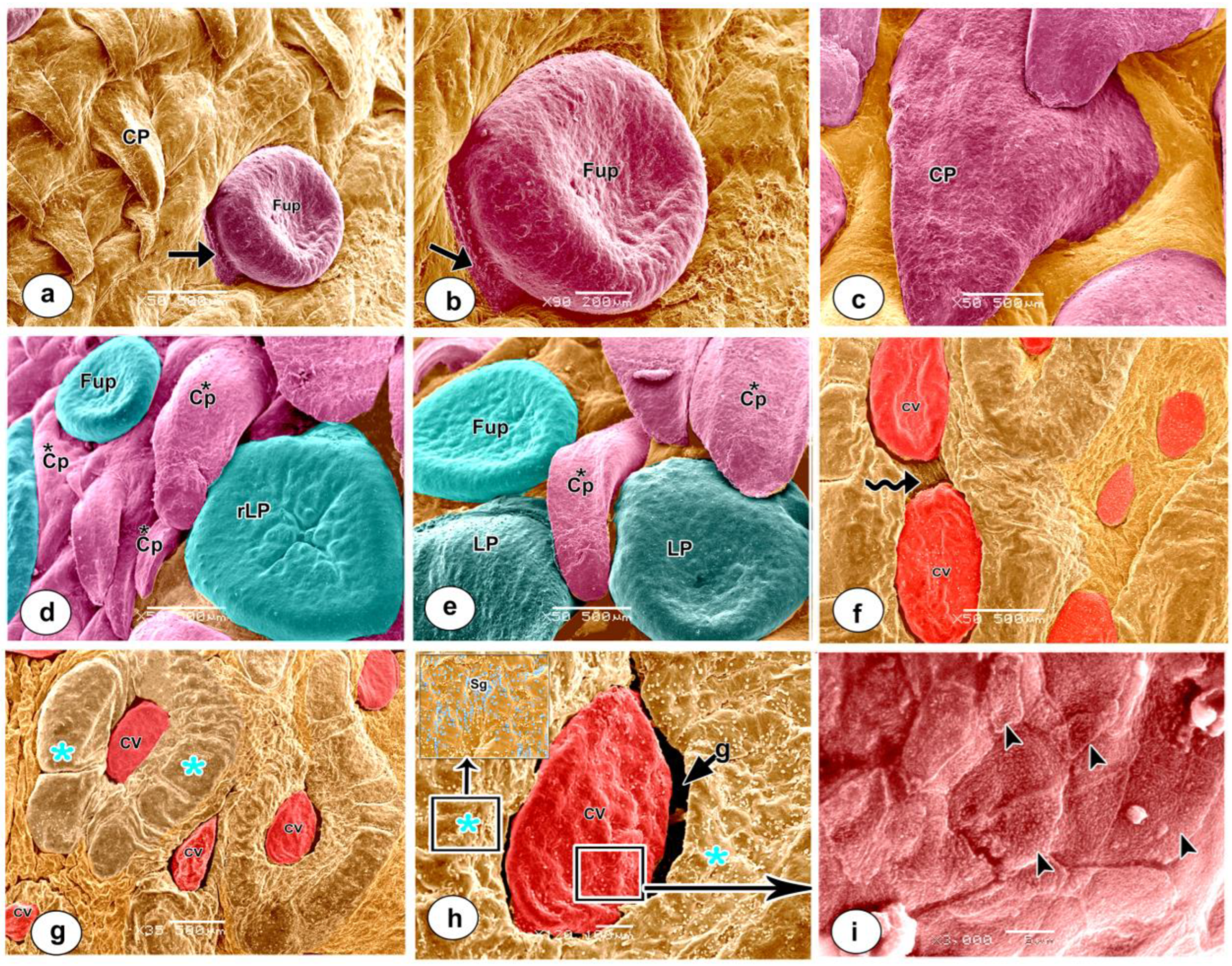
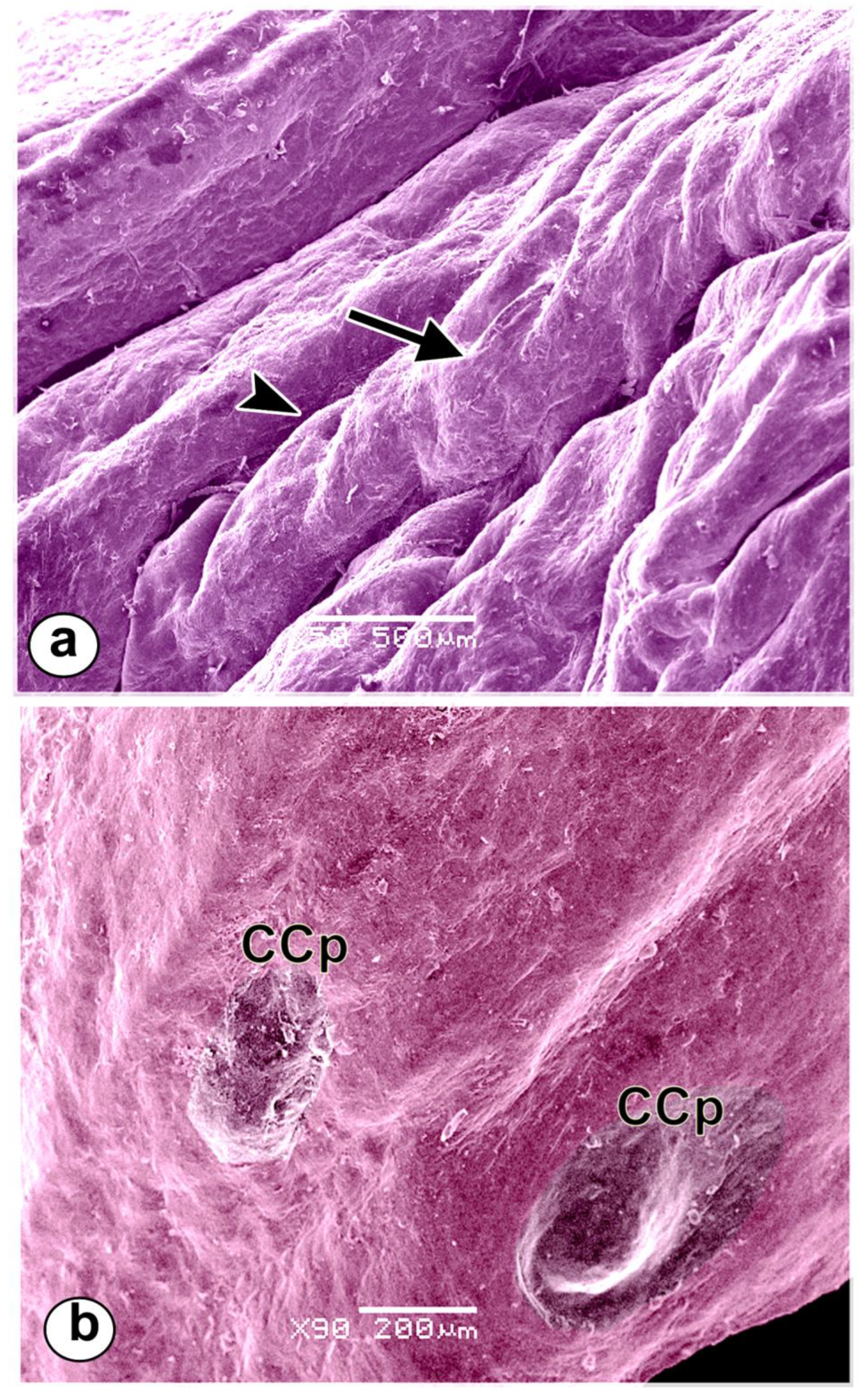
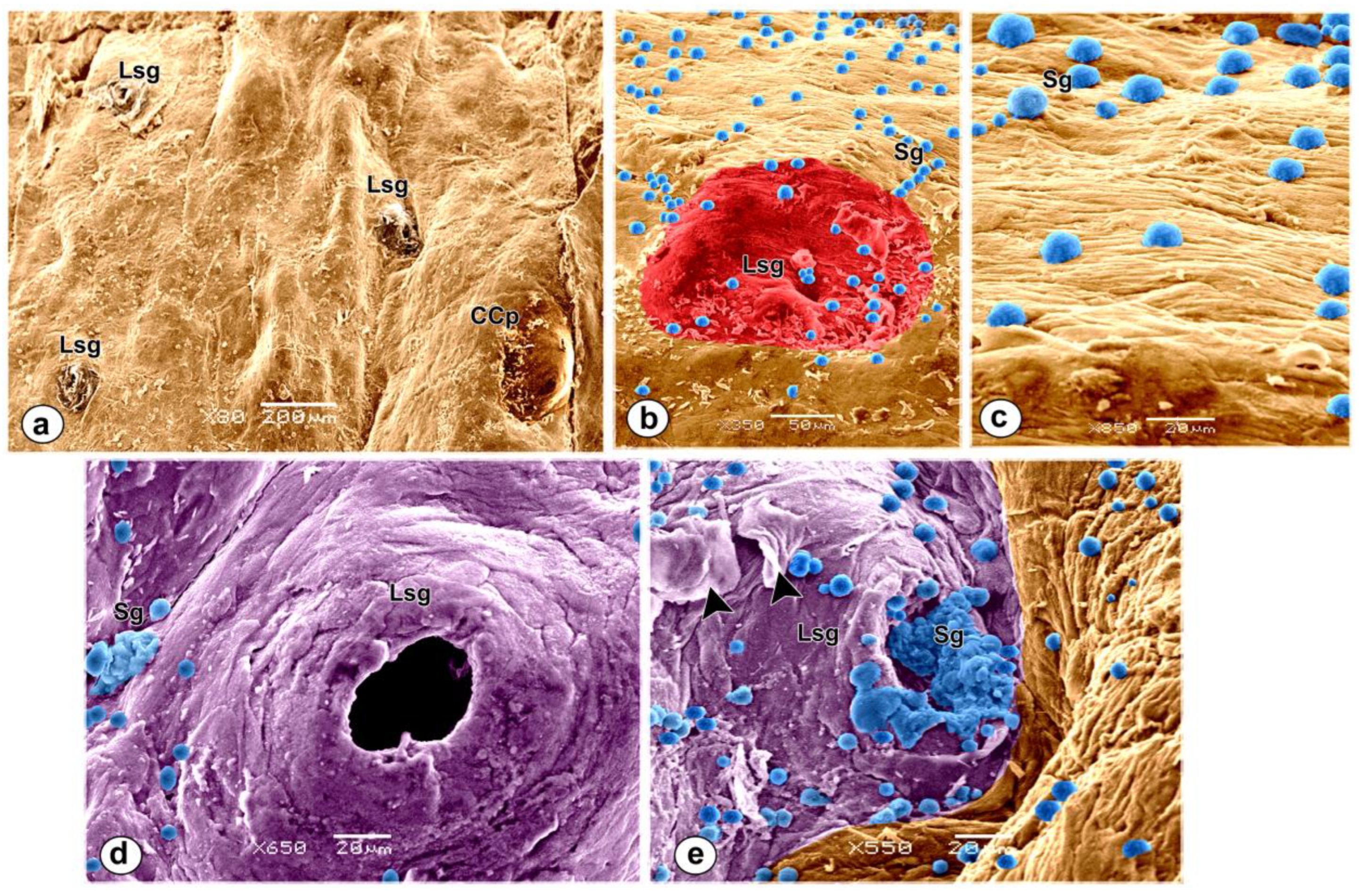
| Dimensions | Mean | SE |
|---|---|---|
| Total length of the tongue | 147.66 | 2.14 |
|
Apex: - Length Thickness at tip Thickness at frenulum linguae Width at tip Width in front frenulum linguae |
41.09 5.675 21.015 20.85 26.56 |
1.89 0.50 2.24 1.25 3.22 |
|
Body: - Length Width of body: - At transverse groove In front glossopalatine arch Thickness of body: - At level of torus Linguae At highest point of torus Linguae At palatoglossal fold |
85.01 32.13 36.5 34.865 48.55 26.9 |
0.08 0.61 1.62 6.03 10.53 3.62 |
|
Torus linguae: - Length Width Distance bet torus linguae & tip of tongue |
54.71 34.55 69.95 |
9.32 3.56 4 |
| Length of transverse groove Length of dorsal longitudinal groove |
20.33 34 |
1.78 2.52 |
|
Root: - Length width |
21.56 31.7 |
0.10 4.31 |
Disclaimer/Publisher’s Note: The statements, opinions and data contained in all publications are solely those of the individual author(s) and contributor(s) and not of MDPI and/or the editor(s). MDPI and/or the editor(s) disclaim responsibility for any injury to people or property resulting from any ideas, methods, instructions or products referred to in the content. |
© 2023 by the authors. Licensee MDPI, Basel, Switzerland. This article is an open access article distributed under the terms and conditions of the Creative Commons Attribution (CC BY) license (http://creativecommons.org/licenses/by/4.0/).





